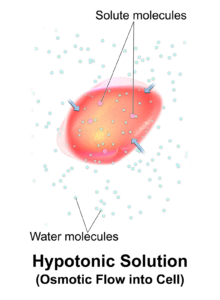This article would be presenting hypotonic solution examples with essential details.
The solutions with lower concentration of solutes than the overall volume of water and which results in lower osmotic pressure are identified as hypotonic solutions. Cells that are placed in the hypotonic solution swell up as the water from the solution moves into the cells.
Hypotonic solutions
The solutions with lower osmotic pressure due to the result of lower concentration of solutes are identified as the hypotonic solutions. When a cell is being placed inside a hypotonic solution, the water from the solution tends to flow inside the cells which further swells it up.
This is mostly because the concentration of water in the solution is greater than the concentration of water within the cell. In terms of solutes, the concentration is higher within the cells than the hypotonic solution.

Biological hypotonic solution examples
Microbes
Protists are organisms which lack a defined cytoskeleton or a cell wall, which would include examples like amoeba or paramecium but, due to the high ability of tonicity control the rigid structure is effectively maintained.
Protists engage in living within a hypotonic solution which allows a constant input of water within the cells. These organisms have “contractile vacuoles” which are specialised organs used in collecting excess water from the cells to be discharged out and eliminate cell lysis.
Plants and Fungi
Fungi and large plants engage in controlling the environment surrounding their cells in order to ensure an environment of hypotonic solution in comparison with the environment of the cells. This leads to the formation of turgid cells which leads to the cells pushing their cell walls outside which further pushes onto other cells to create a rigid structure.
The turgor pressure is maintained with a continuous inflow of water within the cells of the plants under a hypotonic solution which is important for the plants to manage the stiffness and provide the structure. The turgor pressure helps the cells in plants to circulate water throughout the bodies, starting from roots till the top of the stem.
In the Mangroves trees, a hypertonic cytosolic state within the root cells are developed to adapt with the marshy region which helps to absorb the water from the hypotonic environment that surrounds the roots of the plants.
Animal cells
Animal cells lack cell walls and rely entirely on the cell membrane in separating the entry of any substance. The process involved in maintaining the overall solute concentration within an organism is termed as osmoregulation which occurs in all types of animals.
Animals that are living in oceans tend to have salt glands which helps in expelling excess salt out of the body. The animals in the ocean drink gallons of water to maintain the water level in the body but the salt must be excreted to maintain a hypotonic environment for the cells.
Freshwater fishes cannot thrive within seawater due to the differences in tonicity as well as osmotic gradient. Freshwater can be treated as a hypotonic solution which causes the fishes within freshwater to maintain a greater salt content within the cells than the environment surrounding them.
Comparatively, freshwater fishes would have hypotonic cells when it would be exposed to salt water as the external environment would be hypertonic in nature. This would lead to the cells of the fishes to lose water causing extreme dehydration and finally death.
Plasma membrane is identified as an important component for the cells as it is semi-permeable in nature and does not allow the passage of all solutes across the membranes. It helps in controlling the overall flow of the ions moving in and out of a cell. This leads to the establishment of variations in solute concentrations between the cytosol and the fluid of the cell.
Hypotonic dehydration is a common condition where the sodium loss is higher compared to the water loss which decreases the serum osmolarity within the body. This is also termed as hyponatremia. Reduction in serum osmolarity leads to the water flowing from the extracellular to the intracellular region within the cells to cause cellular swelling and edema.
Sodium imbalance within the body can lead to a series of neurological symptoms like nausea, disorientation, headache, lethargy and weakening. In the worst cases it can lead people to coma and even death. Hypotonic dehydration leads to cellular swelling and edema due to excess water retention.
Click to read more on Hypotonic vs Isotonic.
Also Read:
- Protists cell walls and plant cell walls
- Eukaryotic chromosome structure
- Unsaturated fat examples
- Forearm anatomy
- Independent assortment of chromosomes
- Lactose fermenting bacteria examples
- Nucleotide structure insight and significance
- Are algae eukaryotic
- Non motile bacteria examples
- Millipedes examples
Hi, I am Sayantani Mishra, a science enthusiast trying to cope with the pace of scientific developments with a master’s degree in Biotechnology.